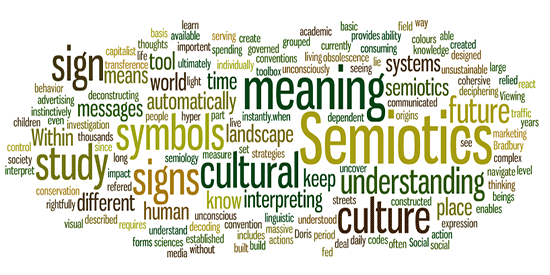Social Semiotics
 |
| Image courtesy of permanentculturenow.com |
Social semiotics is an evolutionary step forward in the methodology of its mother field “semiotics”. The theory of semiotics was first premised by Ferdinand de Saussure (1857-1913), de Saussure defined this field of study as, “the science of the life of signs in society”. (De Saussure, F) His basic theory dissected communication into various parts identified as “signifiers”, which are the form that a word takes (letters/sounds), and the “signified” (the mental concept of the meaning from the signifier). Another contributor to these early works was Charles Sanders Pierce (1839-1914), credited as one of the original founders of American pragmatism. It was Pierce who proposed that human beings can only think in the form of semiotic signs and that it was possible that the whole universe was comprised of nothing more than these same signs. This is important because later it is surmised that the use of these signs is arbitrary, meaning there is absolutely no logical connection between the word and the associated meaning. These findings conclude that all cultures and languages create meaning in their own unique ways.
Social semiotics works to build upon Ferdinand de Saussure’s
concept, by asserting that communication is interpreted and constructed through
social processes, that are constantly evolving due to multifaceted circumstances.
The branch of social semiotics broadens the spectrum of what is considered signs
of communication, from mere linguistics to any semiotic resource available
to human beings utilized for disseminating information (communication). These
resources include multimodal channels, including but not limited to visual,
verbal, written, gestural, musical, etc. This discipline puts a heavy emphasis
on contextual meaning, as the signified meaning can vary based on
context alone.
An exemplar case is that of a rose, this symbol can signify romantic
love in the context of an amorous date, or that of good wishes to a
departed loved one at their funeral. This is significant due to the subjective
nature of all signs and symbols. Therefore, contextual, and cultural backgrounds
are considerable factors in the definition of these terms. Social semiotics weighs in on these variables
and delineates the fact that different modes of communication have different
conventions. This brings us back to the substance of culture, as some cultures preeminently
value written communication, such as that of the “Western” World. This is a
society that primarily uses written language to explain complicated ideas. Whereas
many global cultures rely on spoken traditions to preserve their sense of
history, culture, language, and religious heritage.
The term social semiotics was coined by the
linguistic theorist Michael Halliday when he used this term in the title of
his book “Language as Social Semiotic”. In this work, semiotic resources
are divided into three categories of purpose or metafunctions:
1. 1. Facilitating certain kinds of social and
interpersonal interactions (interpersonal).
2. 2. Representing ideas about the world (ideational)
3. 3. Connecting these ideas and interactions into meaningful
texts and making them relevant to their context. (Halliday, 1978)
From this framework, we can ascertain that communications need to be structured accordingly. Multimodal communication offers up a variety of forms for this usage, however, users need to be aware of the variance in their conventions.
Bezemer, J. (2009, January). (PDF) social semiotics - researchgate. Research Gate. Retrieved December 4, 2022, from https://www.researchgate.net/publication/286459229_Social_Semiotics.

Comments
Post a Comment